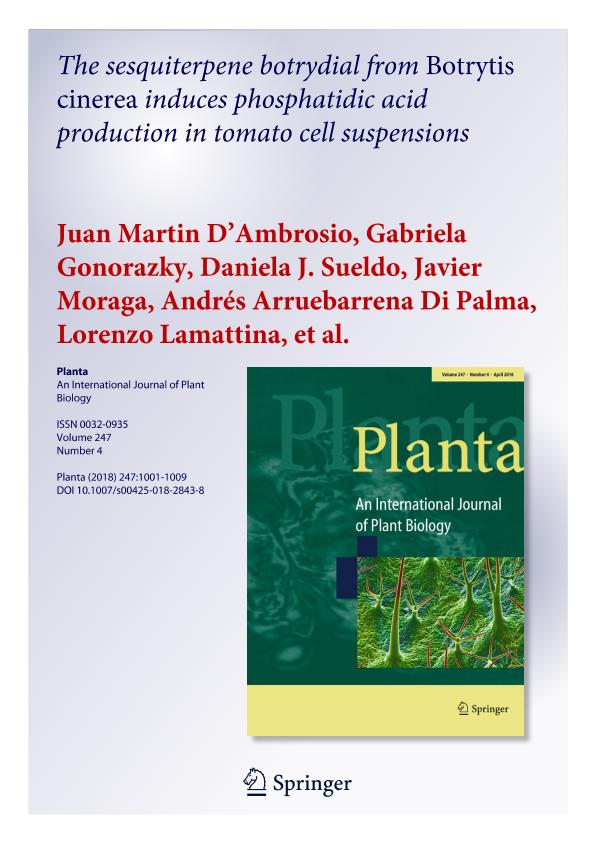Artículo
The sesquiterpene botrydial from Botrytis cinerea induces phosphatidic acid production in tomato cell suspensions
D'ambrosio, Juan Martín ; Gonorazky, Ana Gabriela
; Gonorazky, Ana Gabriela ; Sueldo, Daniela Jorgelina; Moraga, Javier; Arruebarrena Di Palma, Andrés
; Sueldo, Daniela Jorgelina; Moraga, Javier; Arruebarrena Di Palma, Andrés ; Lamattina, Lorenzo
; Lamattina, Lorenzo ; Collado, Isidro González; Laxalt, Ana Maria
; Collado, Isidro González; Laxalt, Ana Maria
 ; Gonorazky, Ana Gabriela
; Gonorazky, Ana Gabriela ; Sueldo, Daniela Jorgelina; Moraga, Javier; Arruebarrena Di Palma, Andrés
; Sueldo, Daniela Jorgelina; Moraga, Javier; Arruebarrena Di Palma, Andrés ; Lamattina, Lorenzo
; Lamattina, Lorenzo ; Collado, Isidro González; Laxalt, Ana Maria
; Collado, Isidro González; Laxalt, Ana Maria
Fecha de publicación:
04/2018
Editorial:
Springer
Revista:
Planta
ISSN:
0032-0935
Idioma:
Inglés
Tipo de recurso:
Artículo publicado
Clasificación temática:
Resumen
Main conclusion: The phytotoxin botrydial triggers PA production in tomato cell suspensions via PLD and PLC/DGK activation. PLC/DGK-derived PA is partially required for botrydial-induced ROS generation. Phosphatidic acid (PA) is a phospholipid second messenger involved in the induction of plant defense responses. It is generated via two distinct enzymatic pathways, either via phospholipase D (PLD) or by the sequential action of phospholipase C and diacylglycerol kinase (PLC/DGK). Botrydial is a phytotoxic sesquiterpene generated by the necrotrophic fungus Botrytis cinerea that induces diverse plant defense responses, such as the production of reactive oxygen species (ROS). Here, we analyzed PA and ROS production and their interplay upon botrydial treatments, employing tomato (Solanum lycopersicum) cell suspensions as a model system. Botrydial induces PA production within minutes via PLD and PLC/DGK. Either inhibition of PLC or DGK diminishes ROS generation triggered by botrydial. This indicates that PLC/DGK is upstream of ROS production. In tomato, PLC is encoded by a multigene family constituted by SlPLC1–SlPLC6 and the pseudogene SlPLC7. We have shown that SlPLC2-silenced plants have reduced susceptibility to B. cinerea. In this work, we studied the role of SlPLC2 on botrydial-induced PA production by silencing the expression of SlPLC2 via a specific artificial microRNA. Upon botrydial treatments, SlPLC2-silenced-cell suspensions produce PA levels similar to wild-type cells. It can be concluded that PA is a novel component of the plant responses triggered by botrydial.
Palabras clave:
DEFENSE
,
NECROTROPH
,
PHOSPHOLIPASE
,
PHOSPHOLIPID
,
PHYTOTOXIN
,
PLANT
Archivos asociados
Licencia
Identificadores
Colecciones
Articulos(IIB)
Articulos de INSTITUTO DE INVESTIGACIONES BIOLOGICAS
Articulos de INSTITUTO DE INVESTIGACIONES BIOLOGICAS
Citación
D'ambrosio, Juan Martín; Gonorazky, Ana Gabriela; Sueldo, Daniela Jorgelina; Moraga, Javier; Arruebarrena Di Palma, Andrés; et al.; The sesquiterpene botrydial from Botrytis cinerea induces phosphatidic acid production in tomato cell suspensions; Springer; Planta; 247; 4; 4-2018; 1001-1009
Compartir
Altmétricas



